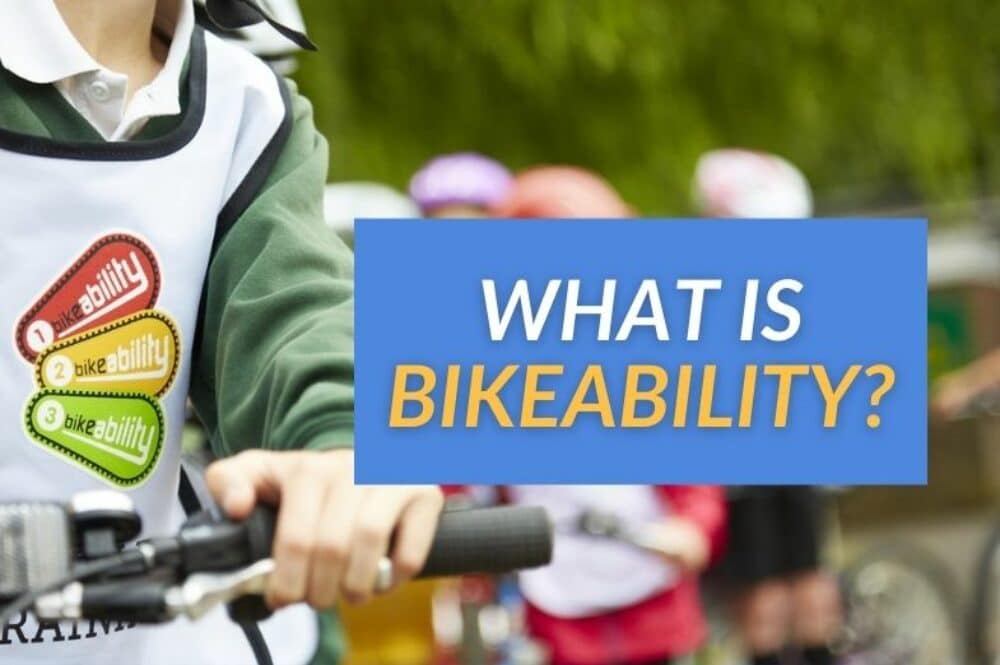This post may contain affiliate links, which help to keep Discerning Cyclist rolling. Learn more.
For many generations, the Cycling Proficiency Test was a right of passage through childhood. But it’s not something you seem to hear about any more.
So, what actually happened to the Cycling Proficiency Test? Do kids still have any formal bicycle education?
Here we explore…
- Does the Cycling Proficiency Test Still Exist?
- What is Bikeability?
- Who is Bikeability For?
- Bikeabilty Levels
- Bikeability Cost
- Where to Find a Bikeability Course
Does the ‘Cycling Proficiency Test’ Still Exist?
The Cycling Proficiency Test stopped being used in 2007. It was superseded by a new scheme, branded ‘Bikeability’, which was introduced by the Department of Transport as part of their National Standard for Cycle Training plan.
What Happened to the Cycling Proficiency Test?
Introduced by the Royal Society for the Prevention of Accidents in 1947 (the Scheme was officially introduced in 1958), the Cycling Proficiency Test ran continuously until it was effectively replaced by Bikeability in 2007.
What is Bikeability?
Bikeability acts as an updated, more relevant, modern-day version of the Cycling Proficiency Test. Its role is to ensure that young people gain the practical skills necessary to be able to cycle on today’s roads safely. That being said, however, the training is available to all ages.
A progressive programme, Bikeability assists everyone with gaining the skills and confidence for various levels of cycling and how to stay safe while doing so.
Who Runs Bikeability?
The Bikeability programme itself is based upon the National Standard for Cycle Training, and is the Department of Transport’s national award provider for cycle training in England. The programme is also approved by the Cycle Training Standards Board.
When engaging with Bikeability, it is recommended to check with your local authorities first as to what they offer in your area. If the training is not being delivered in-school, information is typically available from their website under ‘cycling’ or ‘cycling training’.
Who is Bikeability For?
Bikeability is primarily organised and delivered by its registered providers within schools, mainly for children of the ages Year 5 to 7. However, Bikeability offers its services to individuals of all ages.
So, if you’re thinking of picking up cycling but don’t quite know where to begin or how to responsibly go about it, then Bikeability may be appropriate for you.
What Age is Bikeability For?
Bikeability is primarily introduced to children during in-school programs from the school years of Year 5 to Year 7 (ages 9 to 12). However, Bikeability is available to people of all ages.
Can Adults Do a Bikeability Course?
Adults can participate in Bikeability. Many local authorities have adult cycle training offers under the name of Bikeability, or the National Standard for Cycling Training in which Bikeability is based upon.
Training for adults can also be built around specific needs. For example, if there is a particular route or skill that you may need assistance becoming more proficient in. If you think Bikeability may be for you, but you don’t yet have a bike, we suggest our quiz on how to find the right bike for your needs.
How Many Bikeability Levels Are There?
Bikeability is typically made up of three levels. However, it is not compulsory to do all three of these levels if yourself, or your child, already has an understanding of the basics of cycling.
For children in particular, some may begin their Bikeability training from levels 2 or 3, rather than 1, depending on their experience. Their instructor will check which level is most appropriate before commencing with the training. However, it is recommended that children participate in all 3 levels of the Bikeability programme to ensure that they are getting the most out of the training whilst they have the opportunity.
What is Bikeability Level 1?
At level 1, there are 2 modules made up of four activities that lasts two hours. Individuals will learn how to prepare for their journey, check their bicycle is ready for their journey, and to be able to set off, slow down and stop safely.
This includes controlling their speed, looking behind themselves and being able to cycle one-handed so that they can indicate the direction they’re going in to other travellers.
What is Bikeability Level 2?
At level 2, there are 3 modules made up of eight activities that lasts six hours. These activities include cycling safely, managing risk, responding to hazards, negotiating junctions, complying with various road signals and markings, and being able to communicate effectively with other users of the road.
There will also be teaching on how to maintain a suitable and comfortable riding position, as well as how to safely start and stop during road journeys.
What is Bikeability Level 3?
Finally, at level 3, there are 2 modules made up of four activities that last two hours – similarly to level 1. Individuals at level 3 will learn how to plan their journeys and ride with confidence where cycling is permitted.
After level 3, they will be able to cooperate with other road users, negotiate junctions effections, use cycling infrastructure where present and ride on roads with speeds above 30mph when necessary.
How Long Does Bikeability Take?
Altogether, doing the Bikeability programmes Level 1, 2 and 3 training will take 10 hours. Often, this is spread over a period of time, to give individuals time between lessons to process and practice what they have learnt.
Bikeability Cost
Typically, Bikeability training delivered in schools is free or at a minor cost. For those training outside of schools, there may be different charges incurred that will need to be checked with the provider.
Who Pays for Bikeability?
The cost of Bikeability is typically covered by schools or local authorities, who can apply for funding from the Department of Transport. However, parents may be asked to contribute a small fee towards the training. Training can also be provided privately, in which case the student will pay..
How is Bikeability Funded?
The majority of Bikeability training is delivered in schools for free (or for a minor fee), due to the Department of Transport having funded the scheme. The department invites local authorities and School Games Organiser Host Schools to apply for the funds for the scheme from them each year.
How Much Does Bikeability Cost?
The costs for participating in Bikeability vary depending on whether it is being delivered in school or independently. If delivered independently, you will need to contact your local authority to receive a price for the training. In schools, Bikeability is often free or for a small donation.
In terms of Government funding, it is suggested that it costs £18.33 on average to train a child up to Level 2 of the Bikeability scheme.
How to Find a Bikeability Course
You can find a Bikeability course in your area by visiting the directory on the Bikeability website.
Finding a Bikeability course near you is incredibly easy, as it should be! If your child’s school does not already offer the training, or the training is for someone else, you can find a course local to you by contacting your local authority.
If you wish to learn to cycle or to become more proficient at it, but do not think Bikeability may be for you, then check out our handy guide here with tips and videos!











